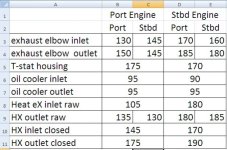Greetings all,
Searched thru the forums but didn't find anything specific to my question.
I'm considering replacing the elbows on my starboard '97 454XL as its running a little warm & I don't know the age of the elbows having just bought the boat last year.* The Crusader part # for the elbows is 98126 for the low profile model which is apparently out of production according to the internet searches I've performed.* Barr seems to be the only one that makes a comparably sized replacement or I can try to switch to the 9015 which are 1.5" taller.* I measured & have a good 2"+ clearance above, but I'd be more comfortable with some air space around the elbows rather than having them almost in contact with the sound insulation foil.
Opinions appreciated! Thanks.
Searched thru the forums but didn't find anything specific to my question.
I'm considering replacing the elbows on my starboard '97 454XL as its running a little warm & I don't know the age of the elbows having just bought the boat last year.* The Crusader part # for the elbows is 98126 for the low profile model which is apparently out of production according to the internet searches I've performed.* Barr seems to be the only one that makes a comparably sized replacement or I can try to switch to the 9015 which are 1.5" taller.* I measured & have a good 2"+ clearance above, but I'd be more comfortable with some air space around the elbows rather than having them almost in contact with the sound insulation foil.
Opinions appreciated! Thanks.


